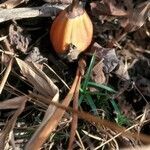Rhizomes, extensive, ± 8 mm. in diameter, buried at least 5 cm. deep in the soil; scales fugaceous.. Leafy shoots to 1.5 m. tall.. Leaves lanceolate, up to 32 × 9 cm., acuminate, base cuneate, glabrous except for a row of minute tooth-like hairs arising from raised bases on the margin; nerves 23-33 per 5 mm. beneath, usually obscured by hypodermal sclerenchyma above. Ligule coriaceous, bifid, the halves unequal, rounded to acute, the longer half 3-10(-16) mm. long, bearing a mixture of simple appressed hairs and reddish glands which collapse and become blackish after long storage; leaf-sheaths sulcate, often reticulate towards the apex, with an indumentum like that of the ligule.. Inflorescence 2-5-flowered, arising at the base of an old leafy shoot which is often represented only by its charred base; peduncle bracts broadly ovate, up to 3 × 2.5 cm., usually pubescent, at least near the apex, with a mixed indumentum like that of the ligule and leaf-sheath.. Calyx spathaceous, 4-5 cm. long, split for 1.5 cm. down one side.. Petals pale mauve to almost white, the posterior oblong, concave, rounded, 4.5-6 × 2-3.5 cm.; laterals narrowly lanceolate, 4-6 × 0.7-1.4 cm.. Labellum ± 8 cm. long, the free portion suborbicular, ± 6 cm. in diameter, pale mauve to almost white, with a yellow patch at the base.. Free filament ± 2 cm. long, ligulate; anther 9-12 mm. long, the lower half dehiscent; apex 3-lobed, the apical lobe triangular with a bifid apex, 2.5 × 5 mm., lateral lobes subulate, to 9 mm. long.. Style appressed pubescent; stigma trumpet-shaped, fringed with hairs.. Fruit ovoid, up to 10 cm. long and 7 cm. in diameter, smooth, with a short beak composed mainly of the base of the calyx-tube.. Seeds ellipsoid, 4-6 × 3-4mm., dark brown, shiny.
More
A ginger family herb. It has creeping rhizomes or underground stems. These are 8 mm across and buried 5 cm deep. It has stems 3 m high. The leaves are large. They are sword shaped and 32 cm long by 9 cm wide. The base is wedge shaped and they taper to the tip. There are 2-5 flowers in a group. They are pale red to white. The lip of the flower is pink, purple or white. The fruit are oval and have a beak. They are 10 cm long and 7 cm wide. The seeds are narrowly oval and 4-6 mm long by 3-4 mm wide. They are dark brown and shiny.


